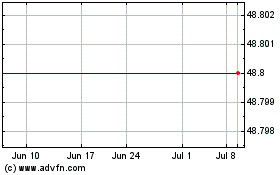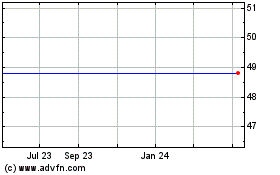Exelon: EPA’s Carbon Rule for Existing Power Plants Can Be Implemented Reliably and on Time Using Existing Market Mechanisms
February 19 2015 - 2:30PM
Business Wire
Company supports voluntary option for
compliance that would reduce emissions, promote reliability and
encourage investment in clean energy
The electric industry can achieve the U.S. Environmental
Protection Agency’s goal to reduce carbon emissions from existing
power plants on schedule and at a minimal cost to consumers without
harming grid reliability or compromising the efficiency of existing
energy markets, Exelon said today.
Testifying before the Federal Energy Regulatory Commission
(FERC) at a technical conference to discuss EPA’s proposed Clean
Power Plan, also known as Section 111(d) of the Clean Air Act,
Kathleen Barrón, Exelon’s senior vice president of federal
regulatory affairs and wholesale market policy, said that
well-designed carbon reduction rules can be a driving force to
modernize our aging electric system, maximize the use of clean
energy and support economic growth.
Barrón said EPA’s Clean Power Plan does not require making a
choice between greenhouse gas regulation and affordable, reliable
energy. Rather, she said our nation can rely on existing market
structures to incentivize investment in clean energy sources.
Exelon supports the call of a number of organizations –
including the Edison Electric Institute, system operators, power
generators, environmental groups, academics and industry trade
groups -- for EPA to give states a way to comply with the Clean
Power Plan by imposing a cost on carbon emissions. Barrón called on
FERC to help facilitate this compliance option.
The proposal, referred to in Exelon’s testimony as the
“Reliability Dispatch Safe Harbor,” builds on existing, proven
market mechanisms, in which grid operators dispatch power plants in
order of their cost to operate. Under the Reliability Dispatch
plan, EPA would determine a single, nationwide adder for carbon
emissions that would result in emission reductions commensurate
with the Clean Power Plan’s overall goals. Carbon-emitting power
generators in states that opt into the plan would include the
carbon fee as a variable cost of operating and the state would be
deemed in compliance with EPA’s interim target. The additional
carbon value would reflect the true cost of operating high-emitting
plants, resulting in more clean energy sources being dispatched to
the grid based on their lower true cost. High-emitting plants would
still be called on when needed in order to meet demand, ensuring
that reliability is not compromised, Barrón said.
Reliability Dispatch would treat all low-carbon power equally,
increasing the competitiveness of existing sources, including
nuclear and hydropower. These resources are essential to FERC’s
mandate to ensure consumers have access to reliable power 24/7 and
in all weather conditions, while meeting EPA’s carbon-reduction
obligation. At the same time, it would provide a strong financial
incentive to invest in new clean energy resources, such as wind and
solar.
To reduce the price impacts of compliance, states could require
grid operators to return the collected carbon adders to utilities
and other electricity suppliers, who would refund them to
consumers, effectively capping the cost of the program.
“We estimate that states could eliminate at least 75 percent of
the rule’s impact on retail electric rates, limiting retail rate
increases to 2 percent to 5 percent on a regional basis,” Barrón
said. “This cost is within the range of routine customer rate
increases, which averaged 3.2 percent among U.S. utilities last
year.”
Exelon Corporation (NYSE: EXC) is the nation’s leading
competitive energy provider, with 2014 revenues of approximately
$27.4 billion. Headquartered in Chicago, Exelon does business in 48
states, the District of Columbia and Canada. Exelon is one of the
largest competitive U.S. power generators, with approximately
32,500 megawatts of owned capacity comprising one of the nation’s
cleanest and lowest-cost power generation fleets. The company’s
Constellation business unit provides energy products and services
to more than 2.5 million residential, public sector and business
customers, including more than two-thirds of the Fortune 100.
Exelon’s utilities deliver electricity and natural gas to more than
7.8 million customers in central Maryland (BGE), northern Illinois
(ComEd) and southeastern Pennsylvania (PECO). Follow Exelon on
Twitter @Exelon.
Exelon CorporationPaul AdamsCorporate
Communications410-470-4167paul.adams@constellation.com
Exelon (NYSE:EXC)
Historical Stock Chart
From Mar 2024 to Apr 2024

Exelon (NYSE:EXC)
Historical Stock Chart
From Apr 2023 to Apr 2024
